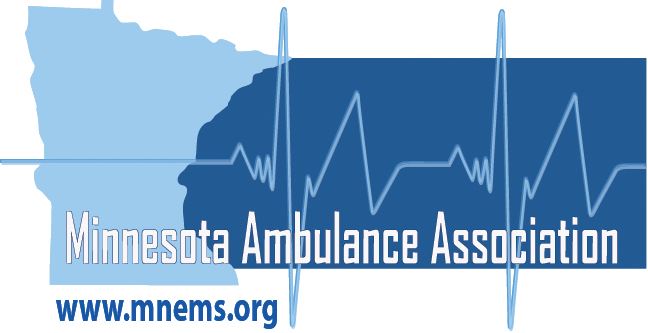- Home
- Advocacy
Legislative Priorities
Who is the Minnesota Ambulance Association?
The Minnesota Ambulance Association proudly stands as the unified voice for EMS across the state, bringing together over 85% of Minnesota's EMS response volume. Our diverse membership comprises both governmental and non-governmental organizations, including Medical Response Units and individual EMS providers.
At MAA, our mission transcends representation; it is a commitment to advancing EMS leadership, shaping impactful policies, and promoting best practices. As stewards of our members' interests, we diligently work to elevate the standards of EMS in Minnesota. Through collaboration and advocacy, we strive to create an environment that fosters innovation, excellence, and continual improvement in EMS services.
Current Challenges:
In recent weeks, media coverage has shed light on the formidable challenges confronting Emergency Medical Services (EMS) in Minnesota. However, it's important to recognize that these challenges are not new; they have persisted over an extended period. The critical issue lies in the widening gap between escalating operational costs and consistently inadequate reimbursement rates, reaching a critical juncture.
Ambulance services are grappling with the monumental task of maintaining operations amidst mounting financial pressures and a dire shortage of qualified personnel. The struggle extends beyond recruitment difficulties for a high-stress profession that demands rigorous initial and ongoing training. Retention proves equally challenging, as dedicated providers are confronted with stagnant wages and benefits that pale in comparison to opportunities in sectors like fast food and retail.
Practical Solutions:
1. Medicaid Supplemental Payment Program (HF 643/SF 595)
In 2023, the Minnesota Ambulance Association introduced legislation that creates an assessment for non-governmental ambulance organizations, allowing ground ambulance organizations to access federal matching funds available through the Medicaid program.
2. Minimum Payment Requirements for Commercial Insurance Payors | State Balance Billing Law
Ground ambulance services often lack the negotiating power required to achieve fair and adequate reimbursement rates from commercial payors, making it extremely difficult for ground ambulance services to become ‘in-network’ with large commercial payors.
Ambulance services are often met with ‘take it or leave it’ style negotiations and the rate they are given by the commercial payor is less than the cost of providing service. This sometimes results in a ‘balance bill’ for the patient.
Establishing minimum payment requirements for commercial payors, ensuring that reimbursement rates are reflective of the true cost of providing the high-quality of care Minnesotans expect and deserve would go a long way in alleviating the financial pressures leading to service closure. Doing this as part of a state Balance Billing law can help protect patients from unexpected, out-of-pocket expenses.States such as Texas, Arkansas, Louisiana, California and, most recently, Florida have all introduced or implemented state balance billing laws that set minimum payment amounts for ground ambulance services. These can serve as examples for Minnesota.
3. Treatment-in-Place and Alternative Destination Legislation (TIP/TAD)
Presently, ambulance services face a reimbursement challenge where compensation is contingent on patient transport to an emergency room, regardless of the actual need for such services. In instances where a patient opts out of transport, the ambulance service encounters an inability to bill or receive reimbursement for the delivered care at the scene.
Enacting legislation that mandates reimbursement for Treatment in Place or Transport to Alternative Destinations is not just a financial remedy; it's a transformative step towards aligning the cost of care with reimbursement for ground ambulance services. Beyond closing the financial gap, this legislation promises to elevate the quality of care for Minnesota residents, curbing the over-utilization of emergency departments and fostering a safer environment for those genuinely in need of emergency care.
S.3236 – Emergency Medical Services Reimbursement for On-Scene Care and Support (EMS ROCS) Act – has been introduced and aims to amend title XVIII of the Social Security Act to provide Medicare coverage of ambulance services that do not include transportation. MN Senator Tina Smith recently signed on as a co-sponsor.
4. Community Paramedic (CP) Certification and Community Emergency Medical Technician (CEMT) Practice Updates
HF 2574 and SF 2660 were introduced in 2023 and referred to the Health Finance and Policy and Health and Human Services Committees, respectively.
HF 2146 and SF 2953 were introduced in 2023 and were referred to the Health Finance and Policy and Health and Human Services Committees, respectively.
These bills update the certification requirements and practice regulations, along with increasing the CP and CEMT rates, along with adding a per mile fee for travel to a patient’s home.
5. Telehealth | Multijurisdictional Communications
HF 553 and SF 1209, both introduced in 2023, directs the EMSRB to implement a multijurisdictional communications and patient logistics platform capable of (1) patient tracking, (2) facilitating the provision of telehealth services, (3) providing information necessary for appropriate destination selection by ambulance service personnel and, (4) collecting information needed to support additional developments in time-sensitive systems of care.
6. One-Time Funding
Engaging proactively, the Minnesota Ambulance Association and its members continue to ply a pivotal role as committed participants in the ongoing sessions of the EMS Sustainability Task Force, demonstrating sustained commitment to the collective efforts of this multi-disciplinary initiative.
As champions of the endeavors of this diverse assembly of ground ambulance service providers and stakeholders, we wholeheartedly support the ongoing initiatives. Together, we are collaboratively explore and working to identify both one-time and sustainable funding opportunities within the state of Minnesota, fostering a robust foundation for the future of EMS sustainability.
